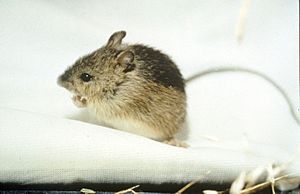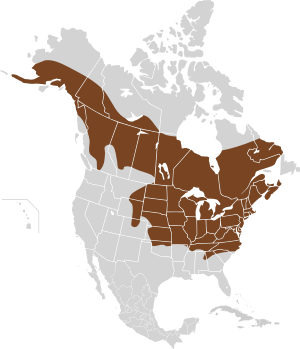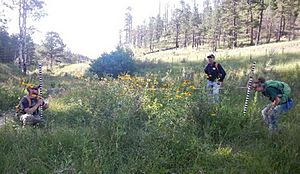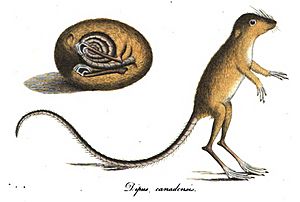Meadow jumping mouse facts for kids
Quick facts for kids Meadow jumping mouse |
|
|---|---|
 |
|
| Conservation status | |
| Scientific classification | |
| Genus: |
Zapus
|
| Species: |
hudsonius
|
 |
|
| Synonyms | |
|
Dipus hudsonius (Zimmermann, 1780) |
|
The meadow jumping mouse (Zapus hudsonius) is a small mouse known for its amazing jumping skills. It lives across a very large area in North America. You can find it from the Atlantic coast all the way to the Great Plains. It lives as far north as Canada and Alaska, and as far south as Georgia, Alabama, Arizona, and New Mexico.
In 2014, a special type of meadow jumping mouse in New Mexico, called Zapus hudsonius luteus, was added to the endangered species list. This means it needs special protection to survive.
Contents
What Does It Look Like?
The meadow jumping mouse is usually between 180 and 240 millimeters (about 7 to 9.5 inches) long. Most of this length comes from its tail, which is about 108 to 165 millimeters (4 to 6.5 inches) long.
One special thing about this mouse is its large back feet. They can be 28 to 35 millimeters (about 1 to 1.4 inches) long. Its front legs are quite short. This makes it look a bit like a kangaroo rat. However, its tail is not bushy at the end, which helps tell them apart.
The mouse's fur is short and a bit rough. It has a dark brown stripe down its back, which looks a bit grayish. Its sides are usually bright yellow to orange, and its belly and feet are white. Female mice are usually a little bigger and heavier than males. Their weight changes a lot depending on the season. In summer, they weigh about 16 to 19 grams (0.5 to 0.7 ounces). Before they hibernate for winter, they can weigh 35 grams (1.2 ounces) or more!
Its tail is two colors: darker on top and lighter underneath. It has a light covering of hair that gets longer towards the tip. The mouse has noticeable ears and long whiskers. Its head is small and narrow, with a short, pointy nose and fairly big eyes.
| Size and Weight (adult) | |
|---|---|
| Length | 180–240 mm (7.1–9.4 in) |
| Tail | 108–165 mm (4.3–6.5 in) |
| Hind foot | 28–35 mm (1.1–1.4 in) |
| Ear | 12–19 mm (0.47–0.75 in) |
| Weight | 11.5–24.8 g (0.41–0.87 oz)
up to 35 g (1.2 oz) or larger before hibernation |
Where Does It Live?

Meadow jumping mice like places with lots of moisture. They can live in many different areas, but they prefer moist grasslands. They also like thick plants near streams, ponds, or marshes. You won't usually find them in heavily wooded areas. They prefer open spaces. As mentioned, they live in large parts of the United States and up into Canada.
How Does It Behave?
The most amazing thing about the meadow jumping mouse is how well it can jump! When it gets scared, it can leap a good distance. Early reports said they could jump six to twelve feet! More recent studies show they can jump about two to three feet. This is still a huge jump for such a small animal! When they are not scared, they usually move around with small hops, only one to six inches long.
These mice are also good swimmers. They often jump into water to escape danger. They push off with their strong back feet, just like they jump on land. Then, they use all four legs to paddle, keeping their head above the water. They can even dive underwater, going as far as four feet deep!
The jumping mouse is also a great digger. It usually digs a burrow by starting in a small dip in the ground. It uses its front paws to dig horizontally. Once inside, it uses its powerful back feet to kick out the loose dirt.
Meadow jumping mice are mostly active at night. Sometimes they come out in the late evening if it's cloudy and moist. This might be because they are looking for food earlier. When handled, they are usually calm. They are not very social animals and usually live alone. However, they are not aggressive towards each other.
What Does It Eat?
Meadow jumping mice mostly eat seeds. But they also enjoy berries, fruit, and insects. When they first wake up from hibernation, they often eat insect larvae, like those of butterflies and beetles. Later in the year, they eat more seeds and a type of fungus.
As fall approaches, they start eating a lot to gain weight for hibernation. They usually start storing up fat about two weeks before they go into hibernation. This is when they gain the most weight. Overall, they are considered seed-eaters (granivores), but they also eat plants (herbivores).
Scientists once did a study to see what these mice liked to eat. They fed caged jumping mice many different plants, fruits like apples and pears, and grains like oatmeal. They also gave them various insects. The mice ate most of the insects, but they didn't like ladybugs or carrion beetles. When they ate plants, they usually only ate the seeds or roots, leaving the rest of the plant untouched.
Hibernation and Life Cycle
Hibernation for meadow jumping mice starts around late September or early October. During this time, their body slows down a lot. They stay in hibernation until about mid-April to May. Males usually wake up a little earlier than females. They lose a lot of weight during hibernation.
When the males wake up, they start eating and are ready to reproduce. Females wake up shortly after. They begin mating, and about two weeks later, most females are pregnant. Pregnancy lasts about 18 days. It can be a bit longer if the female is still nursing her last litter of babies.
On average, a female mouse has about 5 or 6 babies in a litter, but it can be anywhere from two to nine. A jumping mouse can have two to three litters each year. Most babies are weaned (stop drinking milk from their mother) between June and August.
Young Mice
Newborn jumping mice are very tiny, weighing only about 0.8 grams (less than an ounce). They are born naked, blind, and deaf. The only thing they can do is make sounds.
After just one week, their bodies start to get covered with fur, and their claws begin to grow. Their ears start to open, and their hearing begins to develop. Between the first and second week, they start to crawl. By the third week, they can hop, and their hearing is fully developed.
Around the fourth week, their front teeth (incisors) start to grow in. By the end of the fourth week, they have their adult fur, and their eyes are wide open and working. They are weaned and can live on their own within 28 to 33 days.
Who Hunts Them?
The meadow jumping mouse has many natural enemies. These include owls, foxes, hawks, and weasels. Other animals have also been seen eating them, such as common house cats, northern pike fish, rattlesnakes, and even green frogs (Lithobates clamitans).
Conservation Status
Overall, the meadow jumping mouse species is not currently in danger. It is very common across its wide range. Because of this, it is listed as a species of "least concern" by the IUCN Red List.
However, some specific types (subspecies) of the meadow jumping mouse are considered threatened. This is often due to their homes being destroyed or too much grazing by other animals. For example, the New Mexico meadow jumping mouse (Zapus hudsonius luteus) was listed as an endangered species in the United States in 2014. The Preble's meadow jumping mouse is also listed as threatened in the United States.
Taxonomy

In 1797, a British Army officer named Thomas Davies described and drew a jumping mouse found near Quebec. He called it Dipus canadensis.
Later, in 1833, another scientist named Constantine S. Rafinesque described a shrew species he found. After a long time, it was discovered that this shrew was actually the same as the Zapus hudsonius, or meadow jumping mouse.


